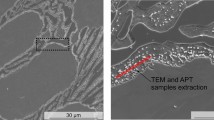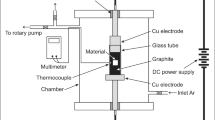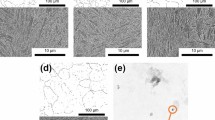Abstract
A CARBIDE which has a needle-like appearance on a polished and etched cross-section is a common occurrence in hot-rolled 3.25 per cent silicon iron. It is metastable with respect to cementite and can be formed by a variety of heat treatments1.
This is a preview of subscription content, access via your institution
Access options
Subscribe to this journal
Receive 51 print issues and online access
$199.00 per year
only $3.90 per issue
Buy this article
- Purchase on Springer Link
- Instant access to full article PDF
Prices may be subject to local taxes which are calculated during checkout
Similar content being viewed by others
References
Leslie, W. C., Fisher, R. M., and Sen, N., Acta Metallurgica, 7, 632 (1959).
Marles, D., J. Iron and Steel Inst., 158, 433 (1948).
Hurst, J., and Riley, R. V., ibid., 149, 213 (1944).
Owen, W. S., and Street, B. G., ibid., 172, 15 (1952).
Author information
Authors and Affiliations
Rights and permissions
About this article
Cite this article
KONOVAL, G., ZWELL, L., GORMAN, L. et al. X-Ray Diffraction Pattern of Carbide in Low-Carbon Iron-Silicon Alloys. Nature 184, 1862–1863 (1959). https://doi.org/10.1038/1841862a0
Issue Date:
DOI: https://doi.org/10.1038/1841862a0
This article is cited by
-
Chemical composition and structural identification of eutectic carbide in 1 pct Mn ductile iron
Metallurgical and Materials Transactions A (1994)
-
Bainite in steels
Metallurgical Transactions A (1990)
-
Microstructural features of magnesium cast iron poured into a block mold
Metal Science and Heat Treatment (1990)
-
The kinetics of carbide precipitation in silicon-aluminum steels
Metallurgical Transactions A (1986)
-
Ein neues tern�res Eisen-Silizium-Karbid
Die Naturwissenschaften (1964)
Comments
By submitting a comment you agree to abide by our Terms and Community Guidelines. If you find something abusive or that does not comply with our terms or guidelines please flag it as inappropriate.



